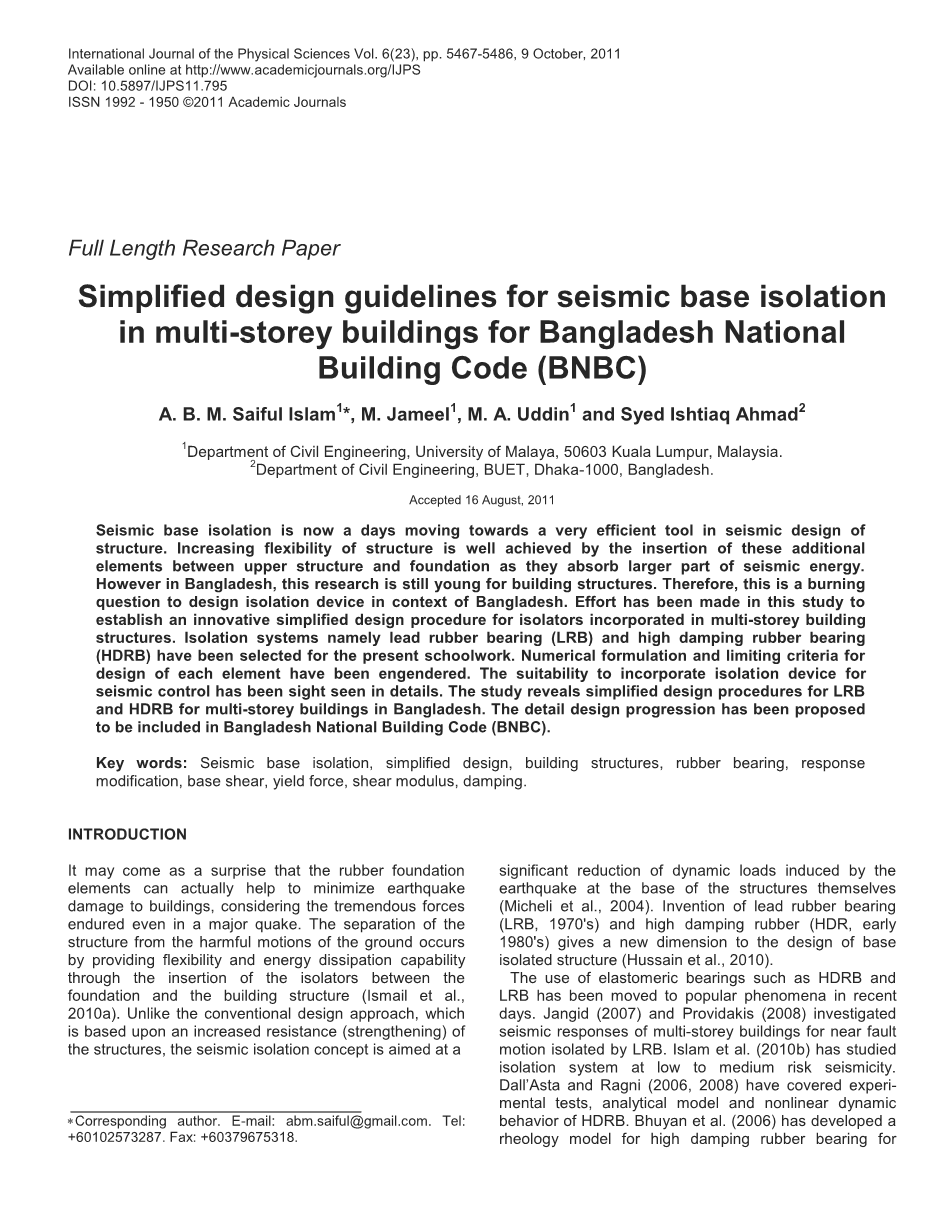

英语原文共 20 页,剩余内容已隐藏,支付完成后下载完整资料
An analytical model for stress–strain behavior of confined concrete
约束混凝土应力-应变行为的分析模型
Baris Binici lowast;
Middle East Technical University, Department of Civil Engineering,˙Inouml;nuuml; Bulvarı, 06531 Ankara, Turkey
Received 28 September 2004; received in revised form 17 February 2005; accepted 17 February 2005
Abstract: It is well known that the strength and ductility of concrete are highly dependent on the level of confinement provided by the lateral reinforcement. The stiffness and the constitutive behavior of the confining reinforcement (elastic, elastoplastic, etc.) are the important factors affecting the behavior of concrete. In this study, a new simple confined concrete model is developed for describing the axial and lateral deformation characteristics of concrete under triaxial compression.The stress–strain relationship of confined concrete in the axial direction is defined with an elastic region followed by a nonlinear curve.The descending region of the stress–strain curve is defined using a constant failure energy criterion.The elastic limit, ultimate strength, and residual capacity of confined concrete are determined using the Leon–Pramono criterion.The lateral deformation of confined concrete is described using a function that provides a smooth transition from elastic to inelastic behavior and satisfies the zero volumetric strain condition at ultimate strength. The model estimations are compared with the results of triaxial concrete compression tests, and fiber reinforced polymer (FRP) and steel confined concrete tests reported in the literature. . It was observed that the model can be successfully applied for FRP and steel confined concrete, removing the need to adjust parameters for different lateral reinforcement types. Finally, a parametric study was conducted to investigate the effect of the lateral reinforcement ratio, concrete strength, and compressive failure energy on the behavior of steel and FRP confined concrete.
摘要:众所周知,混凝土的强度和延展性在很大程度上取决于其箍筋提供的约束力大小.箍筋(弹性,弹塑性等)的刚度和本构关系是影响混凝土性能的重要因素。在这项研究中,建立了一个新型的约束混凝土模型来描述混凝土在三轴压缩下的轴向和侧向变形特征。约束混凝土在轴向上的应力-应变关系由弹性区域和非线性曲线来定义;相对应的混凝土的应力-应变曲线的下降区域使用恒定的失效能量标准来定义,并且采用Leon-Pramono标准,确定了约束混凝土的弹性极限、极限强度和剩余容量。我们可以通过使用一个函数来描述该约束混凝土的横向变形,该函数提供了从弹性到非弹性行为的平滑过渡,同时也满足了在该极限强度体积应变【物体单位体积的改变量】为零的条件。将模型估算结论与混凝土三轴压缩试验、文献中的纤维增强聚合物(FRP)和约束混凝土实验结果进行比较,我们可以发现在极限强度、残余强度以及轴向侧向变形方面能够很好的吻合。据进一步观察可知,该模型可以成功地应用于FRP和钢筋混凝土上面,并不需要因箍筋类型不同的而调整参数。最后我们对模型进行了参数化的研究,来研究钢筋横向配筋率、混凝土强度和压缩破坏对钢和FRP约束混凝土的影响。
copy; 2005 Elsevier Ltd. All rights reserved.
Keywords: Concrete; Confinement; Fiber reinforced polymers
关键词:混凝土、约束、纤维增强聚合物
1.Introduction
1.前言
Reinforced concrete columns and bridge piers are provided with lateral reinforcement to increase the strength and ductility of these members especially when subjected to earthquake induced forces. On the other hand, the use of fiber reinforced polymers to increase the axial load carrying capacity of deficient columns has gained increasing popularity within the last decade. Furthermore, concrete filled steel tubes where the axial load is solely carried by concrete confined by steel tubes [1,2] offer excellent structural systems where both materials are utilized efficiently. The design and detailed analyses of these members can be performed in safe and economic ways as long as a thorough understanding of the confining reinforcement–concrete interactions is available along with models that are capable of representing confined concrete behavior.
尤其是当遭遇到地震力时,钢筋混凝土柱和桥墩设有横向钢筋,以增加这些构件的强度和延展性。另一方面,使用纤维增强聚合物来增加有缺陷柱的轴向承载力这种方法在过去十年中已经越来越受到欢迎。此外混凝土的填充钢管 [1,2],其轴向荷载仅由钢管约束混凝土来承担,这种方式是一种优良的结构体系,能够确保两种材料都能有效地应用。只要充分了解约束混凝土的相互作用以及能够理解约束混凝土行为的模型,就可以以安全经济的方式对这些构件进行设计详细的分析。
Since the recognition of strength gain in concrete as a result of confining reinforcement [3], there has beena tremendous effort to understand and model confined concrete behavior. Some of the earlier models were based on biaxial compression experiments [4–7] whereas some were based on limited experimental evidence regarding softening behavior of confined concrete [8]. Recent triaxial compression experiments [9–13] provided an extended data base on compressive behavior of concrete that can be used to develop and verify confined concrete models.
自从增加混凝土强度的方法被认为是增强钢筋约束的结果以来,人们花了很大精力去理解与模拟混凝土的约束行为。一些早期的模型是基于双轴压缩试验[4-7],而有些则基于有限的关于混凝土软化行为的实验证据[8].最近的三轴受压[9-13]提供了一个可用于开发和验证约束混凝土模型的混凝土压缩性能的扩展数据库。
Models for describing axial stress–strain behavior of steel confined concrete have been developed on the basis of an extensive database of experimental research [14–16].In these models the ultimate strength and the descending region of the stress–strain curves have been adjusted as a function of confinement provided by the lateral reinforcement ratio and uniaxial compressive strength. The simplicity of these models has made them popular for use in capacity calculations and sectional analyses. One important disadvantage of these models is their lack of generality.They are applicable to only steel confined concrete where the confining reinforcement can be approximated by anelastic–perfectly plastic relationship and peak strength is achieved when the lateral reinforcement yields .With recent advances in high strength concrete and high strength steel and with the use of composite materials (i.e. fiber reinforced polymers (FRPs)) as confining reinforcement, these models require further calibrations to overcome their limitations. No matter what kind of function is selected for the softening region, as long as localization is not taken into account, the softening region will exhibit a size effect and objective results cannot be achieved [21].The verification of this argument has been observed in many uniaxial compression
experiments [22,23].The simplest way of regularizing the compressive softening region approximately, which is usually u
剩余内容已隐藏,支付完成后下载完整资料
资料编号:[264958],资料为PDF文档或Word文档,PDF文档可免费转换为Word
以上是毕业论文外文翻译,课题毕业论文、任务书、文献综述、开题报告、程序设计、图纸设计等资料可联系客服协助查找。


